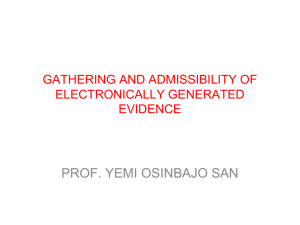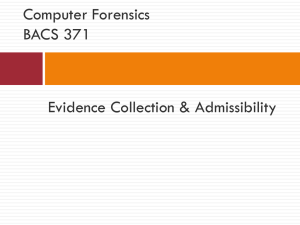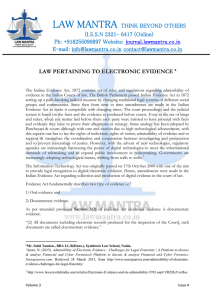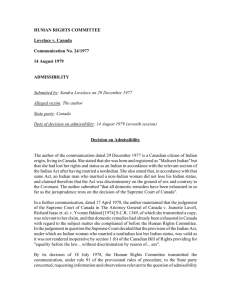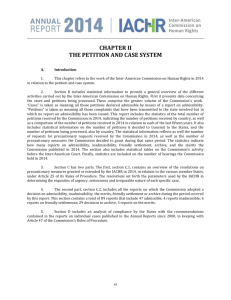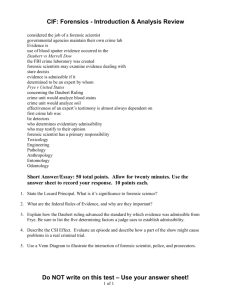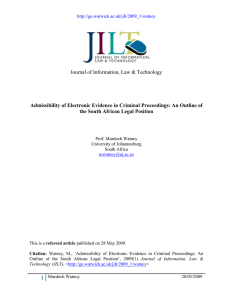admissibility of electronic evidence in nigeria
advertisement
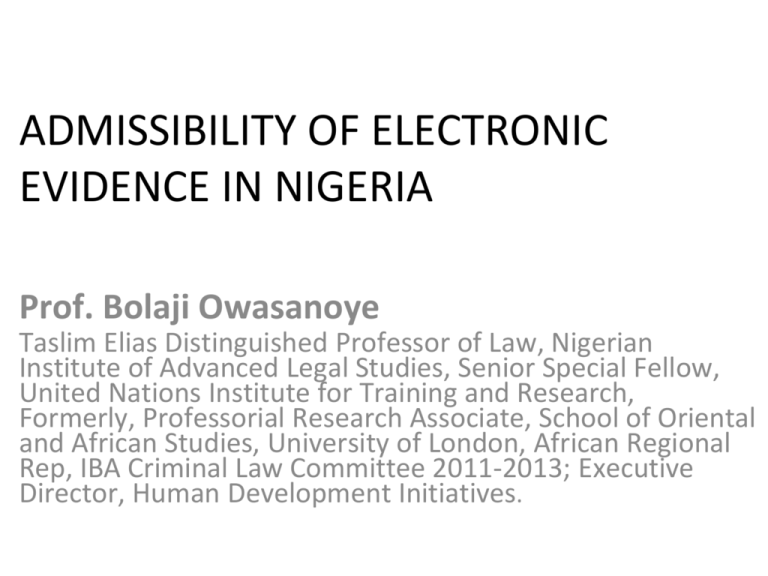
ADMISSIBILITY OF ELECTRONIC EVIDENCE IN NIGERIA Prof. Bolaji Owasanoye Taslim Elias Distinguished Professor of Law, Nigerian Institute of Advanced Legal Studies, Senior Special Fellow, United Nations Institute for Training and Research, Formerly, Professorial Research Associate, School of Oriental and African Studies, University of London, African Regional Rep, IBA Criminal Law Committee 2011-2013; Executive Director, Human Development Initiatives. Conceptual Clarification In this paper the words “Electronic evidence” or “e-evidence” is used interchangeably with the words “Digital Evidence” • We take e-evidence to be legal evidence found in computers and digital storage media or evidence scientifically processed using computer technology. • WE EMPHASIZE THAT COMPUTERS CREATE EVIDENCE AS WELL AS RECORD IT WHAT IS A COMPUTER •S. 258 of the Evidence Act 2011 : • “Any device for storing and processing information, and any reference to information being derived from other information is a reference to its being derived from it by calculation comparison or any other process.” Are These Computers or Not? What is Electronic Evidence? • • • 1. Information in digital format (including electronic records and digital media) used to prove allegations or arguments. 2. Useable in internal investigation, trial before a tribunal or court and in civil or criminal action 3. Used to establish facts – prove or disprove allegations about events that have taken place e.g. creating data on a device, copying data from or to a device, deleting logs or database, establish consistency or continuity of an action or activity, etc. Forms of Digital Storage Media • 4. Electronic evidence is associated with computer forensics in different ways viz: • (a) collecting the electronic evidence: identifying and extracting digital information that can be used to establish proof • (b) protecting the electronic evidence: implementing controls to ensure the integrity of information available in digital format e.g. preserving a database or log book • (c) presenting the electronic evidence: processing information in the context of events such that it is understandable in a tribunal or court of law. Electronic Record or Computer (Digitally) Generated Evidence • • • • • • • • • • Emails Instant Messaging Phone logs POS and ATM transaction logs Social Media records – Facebook; Twitter; Whatsapp; Instagram; Flickr; You Tube videos Digital photos Digital content in DVDS, CDS, Flash disks, Micro SD, Files saved on or printed from Accounting Programs – Peach Tree Data saved on Communication devices, mobile or desk phones, ipod, ipads, tablets, Data retrieved from Cloud Computing Electronic Record or Electronic Evidence Management • • • Electronic records management is at the heart credibility of electronic records and admissibility of such records in trial Traditional methods of archiving and records management do not serve the management of electronic records Main challenge is how to ensure that information in computer systems is a record, which is to say that it is evidence or proof of a transaction • Most collections of electronic data are not records because they cannot qualify as evidence as is. • Challenge is how do we know that electronic data has been captured in a way that makes it a record i.e. a series or a transaction upon which the law and court can rely because it has been captured the way anticipated • For Business Transactions – • S. 51 of EA 2011 says“Entries in books of accounts or electronic records regularly kept in the course of business are admissible whenever they refer to a matter into which the court has to inquire but such statements shall not alone be sufficient evidence to charge any person with liability. • S. 52: “ An entry in any public or other official books, register or record, including electronic record stating a fact ill issue or relevant fact and made by a public servant in the discharge of his official duty, or by any other person in the performance of a duty specially enjoined by the law of the country in which such book, register or record is kept, is itself admissible. Forensic Analysis of Electronic Evidence • • • • • Bearing in mind that electronic data is not necessarily record we face the next challenge what is it? To know what electronic evidence is there must be analysis 1. The main objective of the forensic analysis is to explain the state of a digital artefact e.g. To reassure ourselves that information available on it as a result of a sequence of events 2. To guarantee that what is said to be electronic evidence is truly what it is 3. If electronic evidence is what it is said to be then we can admit it according to law of evidence Collection and Examination of Data • Electronic evidence relating to financial transactions can be collected from many digital sources • Because the character of electronic evidence is so important developed countries have guidelines for investigation and preservation of data. • Guidelines supplement the law and are to ensure admissibility of electronic evidence • In Britain ACPO (Association of Chief Police Officers) Guidelines warns investigators to preserve integrity of electronic data to ensure that it is accurately collected and preserved and there is a chain of custody For example ACPO Principles in England include the following 1. Do not take action to change data on any storage media which may subsequently be relied upon in court. 2. Data in storage should only be accessed by competent persons able to give evidence of what they did 3. Audit trail of what is done to any computer based electronic evidence must be created and kept 4. Any officer in charge of a case must ensure these rules are kept • Electronic evidence recovered for any trial may be taken from a static computer device or live from a running system that is not shut down in order to avoid data loss or service disruption • Analysis is followed by a report which may be oral, written or combined and may be in graphics, voice or text Challenge of Admissibility • • • • • The investigation, acquisition and analysis of digital evidence is dominated by technical rather than legal issues. The presentation of the evidence is however based on the law The report of forensic analysis and conclusions of investigators is presented as evidence The audience is the judge but before the judge/court weighs the evidence the lawyers (prosecution and defence) have a chance to “evaluate” it also The key question is whether admissibility and credibility of electronic evidence is guaranteed because the process is scientific and infallible? International Best Practice • • • • • In the USA developments moved in milestones 1923: Blood pressure deception test case of Frye v. United States, 293 F. 1013 (District Court Circuit 1923; to 1993 Congenital defect case of Daubert v. Merrell Dow Pharmaceuticals, 509 U.S. 579 (1993) US Supreme Court; to 1999 tyre burst case of Kumho Tire Co. v. Carmichael, 526 U.S. 137 (1999), US Supreme Court In summary, USA position is that the Judge is the ultimate GATE KEEPER of admissibility of e-evidence though guided by the 1975 Federal Rules of Evidence • • • • • • • The Daubert process identifies four general categories that are used as guidelines when assessing a procedure: - Testing: Can and has the procedure been tested? - Error Rate: Is there a known error rate of the procedure? - Publication: Has the procedure been published and subject to peer review? - Acceptance: Is the procedure generally accepted in the relevant scientific community? UK • • • • To a limited extent there is still debate that the hearsay rule may apply to digital evidence “Proper working” tests of the computer in question have been established in s.5, Civil Evidence Act (CEA), 1968, and s.69 of the Police and Criminal Evidence Act (PACE) 1984. In both laws the Courts want to be sure the computer evidence is reliable because its source is relaible. In other words, the courts want the source of electronic evidence authenticated Authentication means satisfying the court • • • (a) that the contents of the record have remained unchanged, (b) that the information in the record does in fact originate from its purported source, whether human or machine, and (c) that extraneous information such as the apparent date of the record is accurate. South Africa • • • First is presumption that e-evidence satisfies s.35(5) of SA constitution that illegally obtained evidence must be excluded if admission of such renders trial unfair or will be detrimental to administration of justice. In Narlis vs SA Bank of Athens (1976)2SA 573 theh Court held that s.34 of Civil Proceedings Evidence Act of 1965 did not cover admissibility of computer printout In response the Computer Evidence Act of 1983 was passed to allow e-evidence in civil cases only. The CEA was ineffective so the Electronic Communications Act of 2002 was passed to cover e-evidence in civil and criminal cases ECT Act South Africa • • • • ECT ACT- S.1 defines data as one generated, sent, received or stored by electronic means and includes voice and a stored record S. 15 covers the admissibility and evidential weight of electronic evidence. Section 17 deals with the integrity of the digital evidence Other rules of admissibility of documentary evidence were made applicable to electronic evidence. Nigeria: Before EA 2011 • Esso West Africa Inc. vs T. Oyegbola (1969) 1 NMLR 194 - The Supreme Court said "The law cannot be and is not ignorant of modern business methods and must not shut its eyes to the mysteries of the computer". • In Yesufu v. A.C.B, (1976) 4SC (Reprint) 1 @ 9-14. The Supreme Court upheld an objection to the admissibility of a bank statement prepared by an operator from the Ledger Card of the bank because the bank failed to lay foundation of the existence of a banker's book from which the entries were extracted as well as its custody and control. In addition, it was contended that there was no evidence that copy was examined with the original entry and is correct. • The Supreme Court held that the bank statements purportedly derived from the day-to-day vouchers of the bank were inadmissible without proper foundation being laid as under Section 97 (1)(h) of the Evidence Act 1945. • However in Anyaebosi v. R. T. Briscoe (1987) 3 NWLR (part 59) 84 @ 96-97 a statement of account stored and reproduced from a computer was held to be admissible under Section 97 (1) and (2) of the old Evidence Act 1945. • Similarly in F.R.N v. Fani-Kayode, (2010) 14 NWLR part 1214 p.481, the Court of Appeal, followed Yesufu v. ACB and Anyaebosi v. R. T. Briscoe and held that the computer printout of a bank statement was admissible under Section 97 (1) and (2) of the old Evidence Act. • • • • • • Just as with paper documents and other evidence, electronic evidence must Be Relevant and/or Material: i.e. the information must assist the court do justice Be Credible and/or Competent: i.e. the information must be believable, trustworthy, and true. The question is by what measure can we guarantee that electronic evidence is relevant – S.1 EA 2011, material (S.34), credible – (Hearsay or direct evidence, original or copy and competent? Note that relevance is as determined by s. 1EA 2011. There is also the question of weight s.34 Evidence Act 2011 • • • • 1. What is a document? An expanded meaning by s. 258 “includes: ….any disc, tape, sound track,or other device in which sounds and other data (not visual images) are embodied so as to be capable of being reproduced. Any film, negative, tape or other device in which one or more visual images are embodied so as to be capable (with or without the aid of some other equipment) of being reproduced from it; and any device by means of which information is recorded, stored or retrievable including computer output. WHAT IS A COMPUTER •S. 258 of the Evidence Act 2011 : • “Any device for storing and processing information, and any reference to information being derived from other information is a reference to its being derived from it by calculation comparison or any other process.” •Electronic storage devices can be subjected to obligations of discovery under O.26 R 8 to 14 of High Court of Lagos Civil Procedure Rules 2004 (Now 2012 Rules) Admissibility of Statement in Documents Produced By Computers S.84 EA 2011 Computer is in regular use for storage or processing of information with regard to activity in question Computer was operating properly or if temporarily out of service, that condition did not affect production and accuracy of content of computer information tendered as evidence is derived from information supplied to computer information stored or processed by single, combination or network of computers will be treated as information derived from a single computer information may be supplied to computer directly or indirectly with or without human intervention Transferred or processed information moving from another computer (e.g handheld device) to the main storage computer is admissible so long as it is supplied in appropriate form (84(5) information produced or processed with or without human intervention is admissible A certificate must be produced signed by a person responsible for management of the activities for which the computer is used Certificate must describe manner in which document was produced and provide particulars of device involved in its production; It is sufficient if certificate states that it is to the best knowledge and belief of person issuing it Issues Arising from S.84 EA 2011 1. S.84 assumes that computer evidence will be from a computer within jurisdiction of court. 2. In today’s world of global corporations and businesses this assumption is forlorn. Many TNCs have their operations centrally controlled through complex computer network systems. 3. A computer programed to receive specific data at intervals from satellite feeds is in regular use. Hibernation is not a dysfuntion 4. Proof that a computer is operating properly may not always require expert evidence as stipulated in s.68(1) EA 2011). In R. v Spiby (1991) CLR 199 the Court held that a hotel manager could give evidence to satisfy s. 69 of Police and Crim. Evi. Act, 1984 that a computer was working properly at the relevant time. The argument that only an engineer servicing the computer or an expert in the field was competent to give such evidence was rejected by the Court of Appeal. Issues Arising from S.84 EA 2011 contd. 5. In a global network of computers each transmission from one to other may be modified thus the notion of derived from must be carefully examined 6. . S.84(5) -information moving from one computer to another in appropriate form is software driven and not human determined – e.g. data sharing via network; cloud; same wifi; devices of one registered user etc. 7. Who is more appropriate to be designated responsible for purpose of signing certificate – Network Administrator; IT Manager; Supervising Officer; Data Processor; HOD or just any designated officer within an organisation 8. What particulars of device is to be included in the certificate – hardware or software details; model description; OS, IOS; operating application or serial number Application of S.84 EA 2011 • In Dr. Imoro Kubor & Anor v. Hon. Seriake Henry Dickson & Ors. (2013) 4 NWLR (Pt.1345), 534 Appellants challenged election of the Respondent as Governor of Bayelsa in Feb. 2012 governorship election. • Counsel for Petitioner/Appellant tendered from the Bar at the Election Tribunal, computer printout of online versions of Punch and Independent newspapers and a print out from INEC website • The Respondents did not object so the documents were admitted. • On appeal the admissibility of the exhibits was challenged on two grounds. First, that they were public documents which ought to be certified and secondly that having been tendered from the bar, evidence was not adduced to meet the conditions of s.84(2) of EA. • It was contended that the documents ought to be expunged from the records. Application of S.84 EA 2011 • The Supreme Court agreed with these submissions and held inter alia that “Admissibility of a computer generated documents or document downloaded from the internet is governed by the provision of section 84 of the Evidence Act … A party that seeks to tender in evidence a computer –generated document needs to do more than just tender same from the bar. Evidence in relation to the use of the computer must be called to establish the above conditions … Since the appellants never fulfilled the pre-conditions laid down by law, exhibits “D” and “L” were inadmissible as computer- generated evidence.” Per Onnoghen JSC. • This case is the locus classicus on the point for now but it presents fresh dilemma as it ignores role of technology and impact of egovernance e.g. INEC website, info on NBS portal and even eversion of law reports published by SC. • It implies that electronic alerts and e-mails of bank transactions have no value without certification. Issues Arising from S. 84 EA 2011 contd. S. 84 assumes that evidentiary “document” must still be printed. It ignores expanded definition of “document” in s.258 that “document” may be digital and not require printing • What would have happened assumed the newspapers cited do not have print versions e.g. E-Newspapers -Sahara Reporters; Cable; Premium Times etc. • E-Versions can only be viewed in e-format otherwise print must be from website • If this is in the public domain must there be certification? If Yes by Who? • Rigid application of certification requirement will occasion injustice and ignore modern developments in technology as noted in Esso West Africa vs. Oyagbola • What Should Be the Court’s Approach? • Constantly bear in mind Esso West Africa Inc. vs T. Oyegbola that the law cannot be and is not ignorant of modern business methods and must not shut its eyes to the mysteries of the computer. • Continuously recognize modern developments in technology • Always have right infrastructure and properly trained personnel to ensure the court is digitally compliant • Corroborate digital evidence if possible Original (Primary) or Copy (Secondary) • S. 88 EA 2011 - The main rule remains that documents shall be proved by primary evidence. • S.86. (1) says “Primary evidence means the document itself produced for the inspection of the court.” • Given the expanded meaning of “document” in s.258, the following are documents and can be produced in court as originals- disc, tape; sound track or any device in which sounds or other data (not being visual images) are held and from which data may be reproduced. • With this understanding, transcript of sound on an audio CD will be treated as copy and reproduction of images in a film, negative, tape or other device for storing visual images is a copy • S.86(4) – where a set of documents are made by a uniform process, all are regarded as originals • Exceptions to the Primary Evidence rule are Hearsay Rule • S. 37 and 38 – The main rule on Hearsay remains that a written or oral statement made by a person not called as a witness is hearsay and inadmissible • A statement contained in a book, document or record of any kind which is to be tendered to prove truth of content but which is not declared admissible under EA is hearsay and inadmissible Exceptions to the Hearsay Rule •S. 41: - A statement is admissible when made by a person in the ordinary course of business and in particular when it consists of any entry or memorandum made by him in books, electronic device kept in the ordinary course of business, or in the discharge of a professional duty, or of an acknowledgment written or signed by him of the receipt of money, goods, securities or property of any kind, or of a document used in commerce written or signed by him or the date of a letter or other document usually dated written or signed by him: Provided that the maker made the statement contemporaneously with the transaction recorded or soon thereafter that the court considers it likely that the transaction was at that time still fresh in his memory Exception to Hearsay Rule: E-Business Records •S. 51: - Entries in books of accounts or electronic records regularly kept in the course of business are admissible whenever they refer to a matter into which the court has to inquire but such statements shall not alone be sufficient evidence to charge any person with liability. •S. 52: - An entry in any public or other official books, register or record, including electronic record stating a fact ill issue or relevant fact and made by a public servant in the discharge of his official duty, or by any other person in the performance of a duty specially enjoined by the law of the country in which such book, register or record is kept, is itself admissible. •S.89(h) Secondary evidence may be given of the existence, condition or contents of a document when the document is an entry in a banker's book E-Business Records • Section 90 (1) (i)-(iv) provides for inspection of a banker’s book by a court upon a request of any party to legal proceedings. • Section 90 (1) (i)-(iv) provides for safeguards governing admissibility of banker’s book. These are proofs: • (1) that the book was at the time of the making of the entry one of the ordinary books of the bank, • (2) that the entry was made in the usual and ordinary course of business, and • (3), that the book must be in the custody or control of the bank. The proof in this respect according may be given by a partner or an officer of the bank either orally or by affidavit sworn before any Commissioner for Oaths or a person authorized to take affidavits. Electronic Signatures • S. 93 (1-3) EA 2011 • Electronic signatures are now admissible. • They can be proved in any manner or where it is shown that a procedure was followed by the person executing a symbol or followed some other security procedure for the purpose of verifying that an electronic signature was made to an electronic record. Improperly Obtained Evidence • S.14 EA gives the court a discretion to accept or reject evidence obtained improperly or in contravention of a law: • The discretion is influenced by desirability of admitting as against not admitting • If the court admits, the weight to be attached to such evidence will be determined by the court • Weight is determined by the guidelines in s. 34 EA Weight of E-Evidence • S. 34 EA • Court must consider all circumstances which may affect accuracy • Was the e-evidence supplied to the computer contemporaneously with fact in issue • Did supplier of information have incentive to conceal or misrepresent facts? Nigeria moved close to global best practice in 2011 with passage of new Evidence Act • New Act partly resolves dilemma on • • Reliability/admissibility of computer records; and • Reliability/admissibility of forensically analysed and located data • The law now needs to be tested frequently for scope and interpretation by the courts • • • S.68(1) Evidence Act 2011 formerly s. 57 provides • (1) When the court has to form an opinion upon a point of foreign law, native law or custom, or of science or art, or as to identity of handwriting or finger impressions, the opinions upon that point of persons specially skilled in such foreign law, native law or custom, or science or art, or in questions as to identity of handwriting or finger impressions, are relevant facts. • (2) Such persons are called “experts” S.68 is not basis for automatic admissibility of digital or forensic evidence simply because it is tendered by an expert. The evidence must satisfy requirement of s.84 of Evidence Act of 2011 Conclusion • Lawyers and judges must understand the complexity involved in digital technology and its value in scientific analysis as a prelude to advocating effective laws and principles for investigation and admissibility of electronic evidence in pursuit of civil or criminal justice. • Because of rudimentary understanding of digital technology credibility of information derived electronically is hardly contested by defense lawyers only its admissibility is challenged • The gap is that the conclusions they produce have yet to be tested for reliability • The test of reliability of e-evidence is inevitable once knowledge of how it works becomes widespread. • Although the issue of admissibility will still be crucial but so will be the credibility of the technology used • As the law and infrastructure improve judges, lawyers, academics and other experts must be prepared for the scrutiny that digital evidence will require. • Thank You • bowasanoye@yahoo.com
